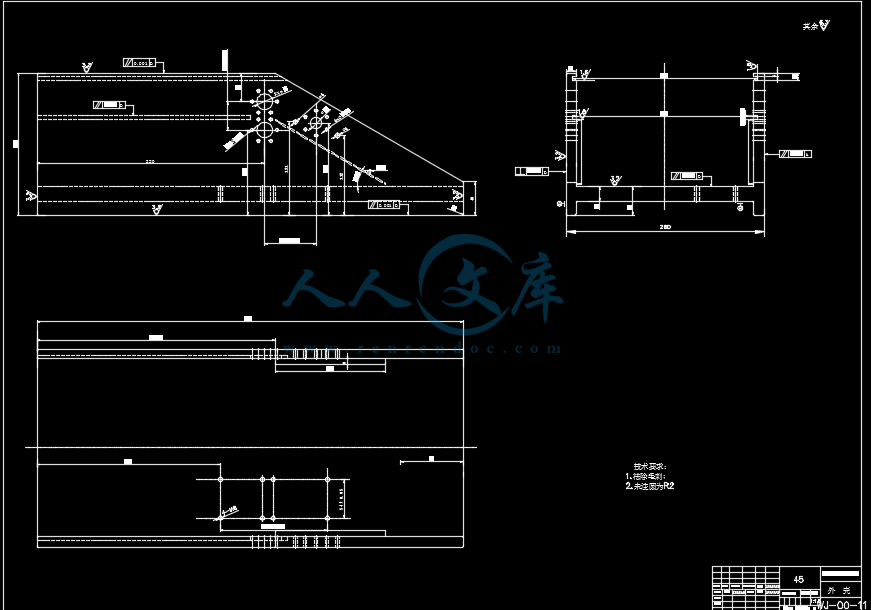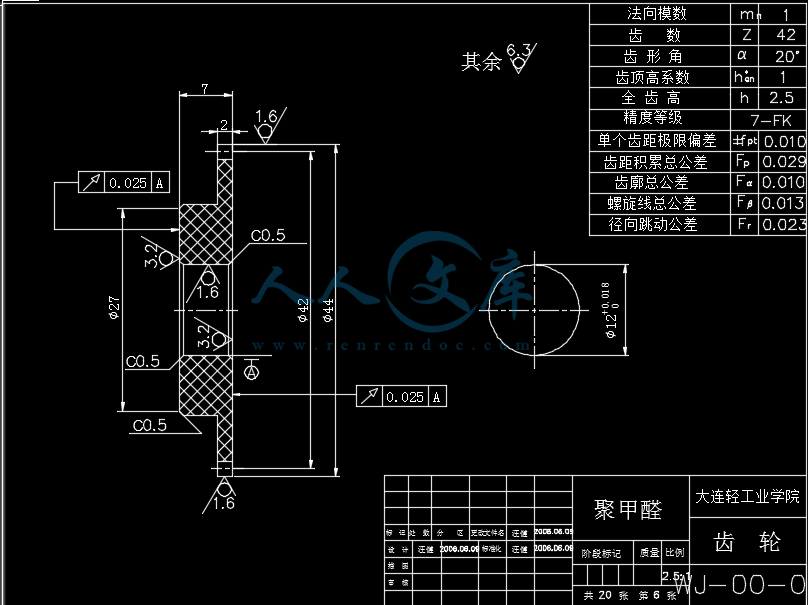摘 要
纸张裁剪机是一种通用的设备,应用范围非常广泛,几乎每个印刷企业都要配置纸张裁剪机,纸张裁剪机在印刷机械产品中占重要的地位。随着社会的进步和科学的发展,造纸业、印刷业对纸张裁剪机提出了更高要求。该文针对国内纸张裁剪机只能单方向剪裁、只能剪裁固定尺寸纸张的缺陷,将横向剪裁与纵向剪裁分开,从纵向滚刀的安装方式和横刀的剪裁时间控制为突破口,设计了一种可以纵横双向剪裁、可以按照商家要求剪裁可变尺寸纸张的纸张裁剪机。用于从事商标、名片和各种印刷制品的剪裁工作。该纸张裁剪机结构简单、动作简洁快速,全套工作流程由PLC控制,具有剪裁质量高,生产效率高的优点。整个设计过程详细论证了其原理方案的可行性和机构的合理性,结构设计全用先进的CATIA软件造型、装配,真实地展示了整个系统的结构尺寸和工作原理。在设计过程中,通过对实际应用产品的设计,增强了对所学专业知识的掌握,提高了对设计思想理念的理解和实际运用能力,同时培养了自己独立完成设计任务的能力,认识到了严谨的工作态度对设计产品质量的重要作用。当然,在本设计中,仍然存在许多不完善的地方,在以后的设计中会加以借鉴,逐步改进。
关键词:变尺寸;双向剪裁;CATIA软件;纸张裁剪机
Abstract
Paper's cutting machine is a kind of general used equipments, its application is very extensive, almost each printing business enterprises have installed paper cutting machine, the paper cutting machine has an important position in printing machine product. Along with the progress of the society and the development of science, there will be a higher request to the paper in paper making industry and print. This text aim at the limitation that the local paper cutting machine can cut only one side and only fixed dimension, separating across cutting and vertical cutting, breaking from the installation of the vertical hob and the time control of the across hob .Design a kind of cutting machine which can cut from both across and vertical and can cut alterable size according to the request of the merchant. Used in the work of cutting label, business card and many kinds of presswork. The structure of this kind of cutting machine is very simple and its motion is prompt. The complete workflow is controlled by the PLC system, having the advantage of high quality of cutting and working with efficiency. The whole design process demonstrates the feasibility of this theory and the rationality of the institution. All of the structure design use the CATIA software to shape and assemble, displaying the size of the structure and work principle of the whole system really. During the design, through the design of the actual apply product, enhance the comprehension of specialty acknowledge and improve the comprehension and actual apply ability of the design idea. At the same time ,develop the ability of completing design mission oneself and understand the important effect of the religious working attitude to design the quality of the product .Certainly, there must be some places not perfect in this design .I will use them for reference in the later design to improve greatly.
Key words: Variation size; bidirectional cutting;
CATIA software; the paper cutting machine
目 录
摘 要1
Abstract2
第一章.前言1
1.1 纸张裁剪机的简介1
1.2 纸张裁剪机国内外情况介绍1
1.2.1 国内情况1
1.2.2 进口情况2
1.3 纸张裁剪机市场前景2
1.4 纸张裁剪机的发展趋势3
第二章.可调尺寸纸张裁剪机原理方案的设计4
2.1 现有纸张裁剪机的结构原理分析4
2.1.1 模切机4
2.1.2 直刃裁纸机5
2.1.3 滚刀裁剪机7
2.2 可调尺寸纸张裁剪机原理方案的设计8
2.2.1 功能原理分析:9
2.2.2 运动原理分析:11
2.2.3 总结分析:11
第三章.可调尺寸纸张裁剪机结构尺寸的设计12
3.1 纵向裁纸机构设计13
3.1.1 纵向裁纸刀的结构设计13
3.1.2 纵向裁纸刀的安装设计14
3.2 横向裁纸机构设计15
3.2.1 横向裁纸刀的结构设计15
3.2.2 横向裁纸刀的安装设计17
3.3 控制装置、总体结构的设计18
3.3.1 控制装置的设计18
3.3.2 总体结构的设计18
第四章.零部件设计25
4.1 纵向裁纸机构零件尺寸的设计25
4.1.1 轴的设计25
4.1.2 电动机功率选择:27
4.1.3 刀具设计:27
4.1.5 仪器仪表滚动轴承的选择29
4.2 横向裁纸机构零件尺寸的设计29
4.2.1 丝杠设计29
4.2.2 光杠设计31
4.2.3 滑块的尺寸设计31
4.2.4 横向滚刀设计32
4.2.5 滚动轴承的选择33
4.3 控制装置、底板和外壳结构尺寸的设计33
4.3.1外壳、垫板的设计33
4.3.2 压板的设计36
4.3.3 盖板的设计36
第五章.其他.......................................38
5.1技术经济性分析......................................38
5.2结 论38
参考文献40
致 谢41
第一章.前言
1.1 纸张裁剪机的简介
纸张裁剪机是一种纸张加工设备,主要用于造纸厂单张纸型纸的加工和印刷企业印刷品的整形加工,蜂窝包装纸板产生以后,也要用到纸张裁剪机切制纸蜂窝芯。近年来,制卡业发展强劲,纸张裁剪机在这个领域也有广阔的市场。
另外,纸张裁剪机应用于非纸类加工,如PS版、皮革、硬塑料等材料的裁切。纸张裁剪机是一种通用设备,应用范围极其广泛,在印刷业中,除部分三印企业外,几乎每个印刷企业都要配置纸张裁剪机,因此纸张裁剪机在印刷机械产品中占重要的地位。在印刷机械产品家族中,年销售量最大的是小型平版印刷机,第二是纸张裁剪机,它在印刷企业中是必备设备之一。
同时,纸张裁剪机又是印后主要设备之一,虽然大批量的书刊整形已由三面切书机取代,大批量的包装产品的由成型模切机、柔性版印刷生产线、瓦楞纸印刷模切开槽机完成。大量的印大切小产品,如商标、不干胶贴片、卡片及中小型印刷企业对小批量印刷产品,用纸张裁剪机对印品加工是投入少,收效快的一种选择,更何况在企业仅纸张尺寸变换、产品的形状变换就需要常备纸张裁剪机。随着科技水平的提高,纸张裁剪机的自动化水平提高很快,液压、程控、计算机控制的纸张裁剪机已占市场主流。
1.2 纸张裁剪机国内外情况介绍
1.2.1 国内情况
国内制造纸张裁剪机的厂家约34家。主要企业有上海申威达、长春印机、四川中江、甘肃平凉普业、山东荷泽生建、浙江嘉路等纸张裁剪机厂。
2001年十家纸张裁剪机厂统计,共销售纸张裁剪机2703台,完成销售额2.84亿元, 2002年七家企业统计,共销售纸张裁剪机2484台,完成销售额2.18亿元。主要纸张裁剪机规格有420mm、580mm、650mm、760mm、780mm、920mm、1150mm、 1250mm、I300mm、1370mm、155 0mm、1660mm、1860mm、2200mm等14种规格。
1.2.2 进口情况
由于我国印刷业飞速发展,每年印刷机械进口量居高不下,纸张裁剪机的进口额也处于增长趋势。2001年进口纸张裁剪机3395台,支付外汇4464万美元。按进口额排序第一德国,进口731台1098万美元。2002年进口切 纸机2134台,支付外汇5995万美元。进口德国616台1930万美元。世界知名企业主要有波拉、沃伦贝格、白发达、唯索普等等。
1.3 纸张裁剪机市场前景
纸张裁剪机有较好的市场前景,主要表现在四个方面:
1) 印刷厂现配备的纸张裁剪机,大都是在印刷业大发展的八、九十年代,那时国产的纸张裁剪机主要是机械式,主要存在问题,一是没有高精度的尺寸定位系统和尺寸设置装置,精度低,不能满足高档印品裁切的要求。二是机械式纸张裁剪机冲击力大、噪音大、安全机构不可靠,容易出工伤事故。三是自动化水平低,没有自动送纸机构,劳动强度大,生产效率低下。这一大批设备需要逐步更新换代。
2) 2002年7月1日国家经贸委发布“第三批淘汰落后生产能力、工艺和设备目录”,明令2003年底禁止生产、使用老式机械式纸张裁剪机。国家新闻出版总署的《印刷业管理条例》和相应的规定中,也不把淘汰设备计算在印刷厂必备条件内,这样就增加了中高档纸张裁剪机市场。当然,淘汰落后设备政策的具体落实还有一定的难度,应该制定具体措施,使其尽快退出市场。
3) 我国印刷品消费水平与世界发达国家和世界平均水平都有相当大的差距。改革开放以来,印刷业发展迅速,印刷企业从2001年印刷业整顿后的15万家,增长到2002年《印刷业管理条例》颁布后的16万家,印刷企业随市场经济发展,将保持继续增长趋势,纸张裁剪机将保持快速增长。2000年印机行业统计销售额达到50亿元,按行业发展规划2010年印刷机械销售额将达到100亿元,印刷机械销售额将翻一番,纸张裁剪机市场增长是必然趋势。
4) 纸张裁剪机进口量较大,出口量较少,如果通过国内企业的努力,在提高产品质量和技术水平上下功夫,通过资产重组,改变当前分散经营,企业成本过高的情况,努力改变多年来进出口反差过大的现状,纸张裁剪机将增大至少30-40%的市场空间。
1.4 纸张裁剪机的发展趋势
根据各个行业的发展需求,纸张裁剪机在市场上有很大的发展前景。但是目前市场上的纸张裁剪机,无论采用模切、直刃还是滚刀都是固定尺寸、单向走刀方式,而市场要求产品结构及尺寸紧跟时代变化,产品的商标、广告尺寸应与产品的外形结构尺寸相协调。所以纸张裁剪机械应顺应产品尺寸变化的要求,适应柔性加工,向着可变更尺寸、多方向走刀的趋势发展。
第二章. 可调尺寸纸张裁剪机原理方案的设计
2.1 现有纸张裁剪机的结构原理分析
2.1.1 模切机
模切机有圆压平、平压平、圆压圆三种机型,目前应用量最大的是平压平机型。平压平模切机又分为立式平压平和卧式平压平机型,而卧式平压平模切机是目前模切机最主要的机型。
无论哪种类型的模切机,其结构都是由模切版台和压切机构两大部分所组成。卧式平压平模切机的模切版台和压切机构的形状都是平板状的。模切版被固定在平整的版台上,被加工板料放在压板(下压盘)上。卧式模切机结构由输料部分、模压部分、出料部分和排废部分等组成。工作时,模切版台固定不动,压板通过连杆作用往复运动,使得版台与压板不断地离合压,每合压一次便实现一次模切。
图2.1 卧式模切机结构
模切机具有结构简单、维修方便、便于操作、适合不同克重的板料、模切精确等优点,但是它的不足之处也是很明显的,例如对于剪裁的尺寸不可调节,只能剪切固定尺寸纸张;它工作时需要有很大的压力,从而导致劳动强度大、生产效率低;模切版台和压切机构长时间受压,容易磨损,寿命不长等等。
2.1.2 直刃裁纸机
所谓直刃裁纸机,即直接用直刃裁刀对纸张进行直线裁剪。根据裁纸刀的驱动方式的不同又分为以下几种情况。
(1) 电机驱动式直刃裁纸机:
工作时,纸张位于工作台上,在张紧轮和平衡轮的作用下,直流电机带动偏心轮转动。偏心轮下面连接连杆,通过桡性杆和摆杆,带动刀片做往复运动,从而对纸张进行裁剪。直刃裁纸机的结构示意图如图2.2
图2.2直刃裁纸机的结构示意图
直刃裁纸机的结构简单,裁剪快速,操作方便。但是裁剪范围有限,对于双向纸张必须分两次裁剪才能完成:而且设备庞大,调整需要大量的时间;成本高,效率低。
(2) 连杆传动式直刃裁纸机:
动作过程与电机驱动式直刃裁纸机基本相同。结构示意图如图2.3所示。
连杆传动式直刃裁纸机承载能力大,易润滑,摩擦小,寿命长。自身能实现力的封闭,不像凸轮要弹簧等配件,能实现多种运动规律和运动轨迹。但是惯性力难平衡(低速),设计复杂,积累误差(空隙),效率低,有急回现象存在。
1、齿轮 2、槽轮 3、直刃切刀 4、电机 5、减速器 6、传送带 7、凸轮
图2.3连杆传动式直刃裁纸机结构示意图
(3) 液压与气压传动式直刃裁纸机:
动作过程与电机驱动式直刃裁纸机基本相同。
在同等的体积下, 液压与气压执行装置能比电气执行装置产生出更大的动力;体积小、重量轻、结构紧凑。执行装置的工作比较平稳,由于重量轻、惯性小、反应快,易于实现快速启动,自动和频繁的换向。传动容易实现自动化,能实现较复杂的顺序动作和远程控制。但是液压与气压传动不能保证严格的传动比,在工作过程中常有较多的能量损失(摩擦损失,泄漏损失) 。液压与气压传动的工作稳定性容易受到温度变化的影响。 为了减少泄漏,元件在制造精度上的要求都比较高,因此它的造价较贵,纸张对油液的污染比较敏感。
(4) 电磁铁吸附式直刃裁纸机:
动作过程与电机驱动式直刃裁纸机基本相同。核心动力结构示意图如图2.4。
电磁铁吸附式直刃裁纸机磁场连续可调、连续性较好。但是磁场稳定性不易保证,而且利用电磁铁的吸附力控制刀具切割纸张,也不容易切断纸张,效率不高。
图2.4电磁铁吸附式直刃裁纸机核心动力结构示意图
2.1.3 滚刀裁剪机
滚刀裁剪机采用了全封闭式调速可逆电机和圆柱型滚刀。结构如图2.5所示,主要由电机、圆柱型滚刀、刀架、齿轮、导向齿、电机支架,底盘、外壳等组成。裁剪部分为两个






 川公网安备: 51019002004831号
川公网安备: 51019002004831号